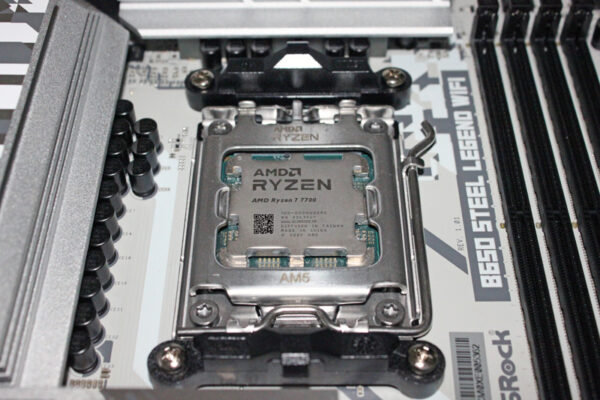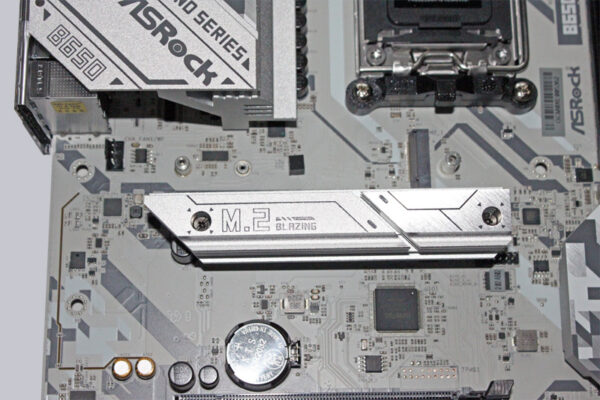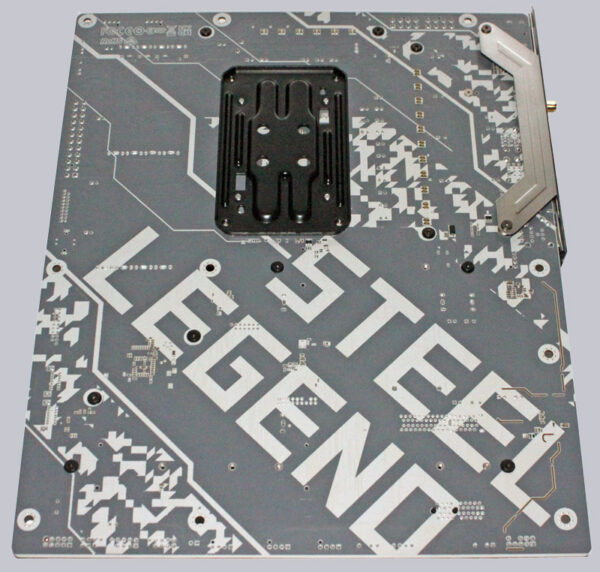
Quickly to the right hardware equipment …
Layout, design and features
ASRock B650 Steel Legend WiFi Chipset
ASRock B650 Steel Legend WiFi Voltage Regulator and Heat Sink
ASRock B650 Steel Legend WiFi Expansion cards
ASRock B650 Steel Legend WiFi Memory
ASRock B650 Steel Legend WiFi SATA connectors
ASRock B650 Steel Legend WiFi USB
ASRock B650 Steel Legend WiFi Network
ASRock B650 Steel Legend WiFi Sound
ASRock B650 Steel Legend WiFi RGB lighting
ASRock B650 Steel Legend WiFi ATX equipment and other features
ASRock B650 Steel Legend WiFi PC System
Layout, design and features …
The ASRock B650 Steel Legend WiFi is based on an 8-layer PCB and accommodates the AMD AM5 LGA 1718 socket.

It currently supports all AMD Ryzen Zen4 CPUs from the 7000 series, including the Ryzen 7000X high-performance CPUs and the Ryzen 7000 CPUs without an X in the name, which have the same number of cores as the high-performance CPUs but are powered with less power by default. The new AMD Ryzen CPUs with additional 3D cache are of course also compatible. With the introduction of the AM5 socket, AMD promised to support CPUs released by 2025. The predecessor AM4 was compatible with 4 CPU generations (Zen, Zen+, Zen2 and Zen3). Here you can see the new CPU socket with an installed CPU.

The ASRock B650 Steel Legend WiFi has 14+2+1 power phases and 80A DR.MOS for VCore. Also on board are 20K Black Caps capacitors. For the ears, there is 7.1 HD audio via the Realtek ALC4082 codec with Nahimic Audio support. It also has a blazing M.2 slot for PCIe Gen5 x4 modules with up to 128 Gb/s connection, which is located below the CPU socket. Some PCIe Gen5 SSDs are now commercially available. Two further Hyper M.2 slots for PCIe Gen4 x4 modules with up to 64 Gb/s are located below the second PCIe x16 slot. Passive heat sinks are already pre-assembled for all M.2 slots, with captive mounting screws. This saves a lot of trouble when installing the cooler. Unfortunately, there are no practical quick-release fasteners for attaching the M.2 SSDs. The Gen5 slot is compatible with module sizes from 2230 to 22110, the two Gen4 slots accept 2280 modules, as is common with M.2 SSDs.

The two M.2 Gen4 slots are covered by a large, passive heat sink. Unfortunately, access is covered when a graphics card is used in the lower PCIe16 slot, but this should not be a problem for most users.

Chipset …
At the heart of the ASRock B650 Steel Legend WiFi motherboard is the B650 chipset from AMD. Four new chipset variants were introduced with AM5 and Ryzen 7000. The X670, the B650 and an Extreme version of each. All chipsets support overclocking, USB 4 and DDR5. DDR4 is no longer supported. X670 and B650 chipsets differ less than you might think. B650 motherboards use a single Promontory-21 chip, whereas X670 motherboards have two Promontory-21 chips. This means that B650 and X670 motherboards basically offer the same functions, but the second Promontory-21 chip on X670 motherboards enables more high-speed connections to the CPU for additional M.2 slots, PCIe slots or USB sockets. Below is an overview of how AMD has planned the connection of the interfaces. A different design by the motherboard manufacturer is possible.
| AMD AM5 Chipset comparison | |||||
| Chipset | PCIe total | PCIe Gen5 | USB 3.2 Gen1 | USB 3.2 Gen2 | SATA |
| X670E | 44 | 24 | 12 | 2 | 8 |
| X670 | 44 | 8 | 12 | 2 | 8 |
| B650E | 36 | 24 | 6 | 1 | 4 |
| B650 | 36 | 0 | 6 | 1 | 4 |
The B650 is therefore by no means a cheap chipset. It is completely sufficient to operate the currently fastest graphics card, the NVidia RTX 4090, as well as M.2 SSDs with transfer rates of 10,000 MB/s and more without restrictions. It can also be used to fully exploit and overclock the fastest Ryzen 7000 CPUs. A significantly weaker chipset, such as the A320 under AM4, has not yet been officially announced by AMD, but the first rumors of a more cost-effective entry-level chipset are already circulating. As AM5 requires a new CPU and new RAM compared to AM4, the AM5 platform is currently still mainly aimed at enthusiasts who want to assemble new, high-performance PCs.
Voltage Regulator and Heat Sinks …
On the 17 Smart Power Stages there is a decent aluminum heat sink, which ensures good cooling. It is worth mentioning that the BIOS battery is not located under the heat sink, as is the case with other manufacturers. This is located further down on the board, making it easier to replace.

Even the back of the motherboard is quite impressive. Unfortunately, the standard user will not have the pleasure of seeing this image more than once during installation. The CPU backplate is solid and even the MOSFET heat sink has a backplate.

Expansion cards …
The upper of the two steel-reinforced PCIe X16 slots is a Gen 5 slot. The lower slot has a Gen 4 connection, which is not a limitation even for the fastest graphics cards currently available, the NVidia RTX4090 and the AMD RX7900XTX. Both PCIe slots are shielded for optimum stability and signal quality and have an SMT design.

Memory …
AM5 heralds the start of a new RAM era at AMD. DDR4 is history, because AM5 and Ryzen 7000 processors only support DDR5 RAM, which is not compatible with DDR4. The B650 Steel Legend WiFi offers four DDR5 memory slots with dual-channel support for memory modules with a total capacity of up to 128GB without external ECC (error correction). On-die ECC naturally takes place on each DDR5 module itself, regardless of whether the board supports ECC or not.

Ryzen 7000 CPUs are specified up to a speed of DDR5-5200. However, the B650 Steel Legend WiFi already officially supports speeds up to DDR5-6600, and with further BIOS updates, even higher transfer rates may be supported later if correspondingly fast memory modules are available. Here you can see Kingston Fury Beast DDR5-6000 modules in slots A2 and B2 for optimal dual-channel support.

SATA connectors …
The ASRock B650 Steel Legend WiFi offers a total of four angled SATA3 ports with 6 Gb/s, which are connected to the CPU via an ASMedia AS1061 chip. Raid modes 0, 1 and 10 are supported on both the SATA ports and the M.2 ports. The necessary programs for RAID configuration and installation are available for download on the ASRock website.

USB …
An USB Buchsen mangelt es dem ASRock B650 Steel Legend WiFi nicht im Geringsten. On the contrary, there are a total of 9 Type-A sockets and one USB-C socket on the rear I/O panel. The USB-C socket delivers maximum transfer rates of up to 20 Gb/s and a charging capacity of up to 27W (9V/3A) in accordance with the PD 3.0 Quick Charge standard for mobile devices or battery packs. There are also five USB-A 3.2 Gen 2 sockets with 5 Gb/s, one of which runs via its own controller and has the lowest latencies for mouse and keyboard for eSports professionals and ambitious hobby gamers. However, this has a bandwidth of 10 GB/s and has a light blue inlay. There are also four USB 2.0 sockets, one of which serves as a flashback port.

The number of usable USB ports can be significantly expanded via internal pin headers. Two headers are available for a total of four USB 2 ports (480 Mb/s), two headers for two USB 3.2 Gen 1 ports (5 Gb/s) and one header for a USB 3.2 Gen 2×2 header for front USB-C with 20 Gb/s.
Here you can see the possible USB transfer rates as a comparison in a table.
| USB interface comparison | ||
| Transfer rates | ||
| Interface | theoretical | practical |
| USB 2.0 | 480 MBit/s | 30 MByte/s |
| USB 3.0 | 5 GBit/s | 450 MByte/s |
| USB 3.1 Gen1 | 5 GBit/s | 450 MByte/s |
| USB 3.1 Gen2 | 10 GBit/s | 800 MByte/s |
| USB 3.2 Gen1 | 5 GBit/s | 450 MByte/s |
| USB 3.2 Gen2 | 10 GBit/s | 800 MByte/s |
| USB 3.2 Gen2x2 | 2×10 GBit/s | 1600 MByte/s |
| USB 4.0 | 40 GBit/s | 4000 MByte/s |
Network …
In terms of network connectivity, the ASRock B650 Steel Legend WiFi offers an RJ45 LAN port that supports the operating modes 10, 100, 1000, 2500Mb/s and is connected via the Dragon RTL8125BG chip. A Wi-Fi 6E module is also integrated. This enables Wi-Fi 6E (6GHz, 160MHz, dual band 2×2) and Bluetooth 5.2 standard connections to be established via the enclosed antenna. Of course, older connection modes according to IEEE 802.a/b/g/n/ac are also supported. Network traffic can be optimized with the Killer LAN software and Killer DoubleShot Pro, which results in a theoretical maximum total bandwidth of up to 4.9 Gb/s when using LAN and WLAN simultaneously.
Sound …
Of course, the B650 Steel Legend WiFi doesn’t neglect sound either. The motherboard is equipped with a Realtek ALC4082 7.1 HD audio codec. The audio section also has impedance detection, which means that the use of both low-impedance and high-impedance headphones with up to 600 ohms is no problem. For 7.1 sound, however, the S/PDIF output on the rear panel must be used.

RGB lighting …
With its basic white color and anthracite accents, the B650 Steel Legend WiFi is already a real eye-catcher without additional lighting, but of course a little RGB should not be missing. There are six RGB SMD LEDs underneath the lower M.2 SSD cooler. The board also has additional headers for connecting RGB-illuminated devices.

All RGB LEDs connected to the motherboard can be controlled via the UEFI BIOS or the Polychrome Sync RGB software provided by ASRock. For optimal control of the addressable LEDs, the number of connected LEDs for each port can be specified in the program.

In the ASRock Polychrome RGB Software Video we explain the included ASRock RGB software.
Note: Please allow our cookies first to see this external content!
Equipment and other features …
The ASRock B650 Steel Legend WiFi has numerous useful features, such as the ASRock A-Tuning Tool, ASRock Instant Flash, BIOS Flashback, NVMe Sanitization Tool, SSD Secure Erase Tool, Digi Power, ASRock RGB LED, ASRock Polychrome RGB and ASRock FAN-Tastic Tuning, Blazing OC-Tuner, PD 3.0 Quickcharge and Auto Driver Installer.
The BIOS Flashback function is particularly noteworthy here, as the AM5 platform is also designed for future CPU generations, but their specifications cannot yet be stored in the BIOS and will only be added later when the new CPUs are released. The necessary BIOS update can then be carried out using a USB stick without a CPU being present.
Test System …
For the test of the ASRock B650 Steel Legend WiFi, we put, as already seen, an AMD Ryzen 7 7700 CPU in the AM5 LG1718 socket, which now works identically in handling as an Intel CPU socket for many years. This means that the risk of bending the CPU pins has disappeared. On the other hand, the delicate springs in the LGA socket must now be well protected. For this reason, the plastic cover should always be inserted when there is no CPU in the socket.
The CPU has notches on two sides and one corner is marked with a golden triangle. If you pay attention to these details, you cannot insert the CPU into the socket incorrectly. If the CPU is seated correctly, the next step is to clamp it in place with the bracket mechanism, whereby the protective cover of the socket pops off by itself, as we have also explained here in the CPU installation guide. We installed the original AMD CPU cooler with the cool RGB lighting. This should be sufficient for our purposes in terms of cooling performance.

We insert a 16 GB RAM module into two of the four DDR5 slots. We insert the two Kingston RAM modules into the slots labeled A2 and B2 on the motherboard to get the best performance. For motherboards with daisy chain topology, the slots at the end of each channel should always be fitted first in order to minimize interference from external sources. The configuration described above gives us a dual channel single ranked setup, which should be particularly stable. We use a SATA SSD and three SATA HDDs to turn the computer into a data storage system that is operated via a Linux-based Unraid OS.

The necessary power is supplied by a BeQuiet Pure Power 12 M with 750 watts, which provides more than enough power reserves for the Ryzen 7 CPU with integrated graphics unit.

ASRock B650 Steel Legend WiFi UEFI and Overclocking …

